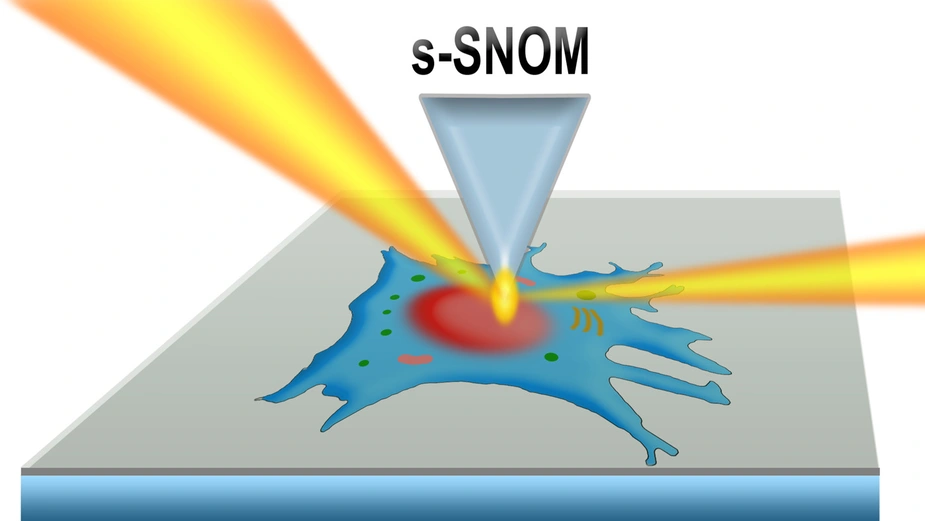What vibrating molecules might reveal about cell biology
At BESSY II, molecular vibrations in tiny biological samples can now be detected and analysed
Infrared vibrational spectroscopy at BESSY II can be used to create high-resolution maps of molecules inside live cells and cell organelles in native aqueous environment, according to a new study by a team from HZB and Humboldt University in Berlin. Nano-IR spectroscopy with s-SNOM at the IRIS beamline is now suitable for examining tiny biological samples in liquid medium in the nanometre range and generating infrared images of molecular vibrations with nanometre resolution. It is even possible to obtain 3D information. To test the method, the team grew fibroblasts on a highly transparent SiC membrane and examined them in vivo. This method will provide new insights into cell biology.
Infrared spectroscopy is a damage free method for characterising biological tissues or cells. With use of an infrared scattering-type near-field optical microscope (s-SNOM) even the smallest sample volumes are sufficient to gain rich information about the molecular composition, structure and interactions, with a spatial resolution of down to 10 nm.
Testing the method on fibroblast cells
The IRIS beamline at BESSY II synchrotron source provides highly brilliant and the extremely broadband infrared light required by this method. In a recent study conducted at BESSY II, under the joint leadership of Dr. Alexander Veber, HZB and Prof. Dr. Janina Kneipp from HUB, a team demonstrated the effectiveness of this method to record vibrational spectra of living cells in liquids on example of fibroblasts, which are responsible for building connective tissue and producing collagen, as test samples.
For the first time, the team used an ultra-thin silicon carbide membrane that serves as a protective biocompatible interface between the cells and their liquid medium and the probing tip of the s-SNOM based infrared nanoscope, which detects the vibrations.
Mapping proteins and other molecules
‘Not only were we able to visualise the nucleus and cell organelles, but we succeeded too in reading the individual contributions of proteins, nucleic acids, carbohydrates and membrane lipids based on the detected vibrational spectra,’ says Veber. This was possible because the silicon carbide membrane is highly transparent to infrared light. The observed cell structure at the nanoscale is consistent with the known heterogeneity of cells, thus validating the new method.
3D information
‘We could also vary the measurement parameters in order to control how deep into the sample we detect signals—allowing us to explore its different layers. This paves the way towards infrared nano-tomography of the cells, i.e. a detailed 3D visualisation of cell structure and composition,’ says Veber. Standardised 2D and 3D vibrational imaging and spectroscopy could enable faster progress in biophysics and nanomaterials.
‘This method offers the possibility of analysing biological samples and liquid-solid interfaces much more accurately than was previously possible,’ says Veber. ‘In principle, we could use it to examine any type of cell, including cancer cells.’ The new development is available for national and international user groups of the IRIS beamline.
Infrared nano-spectroscopy and imaging at BESSY II
Publication:
Small (2025): Nano-infrared imaging and spectroscopy of animal cells in liquid environment
Alexander Veber, Cecilia Spedalieri, Janina Kneipp
DOI: 10.1002/smll.202507097
Contact:
Helmholtz-Zentrum Berlin für Materialien und Energie
Dr. Alexander Veber
Institute Institute for Electronic Structure Dynamics
(030) 8062-13443
alexander.veber(at)helmholtz-berlin.de
Dr. Antonia Rötger
Press Officer
(030) 8062-43733
antonia.roetger(at)helmholtz-berlin.de
HZB press release, 16 October 2025
